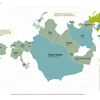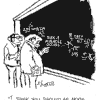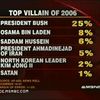5.11.2007 | 17:19
No evidence of Iranian nuclear-weapons program, experts say
No evidence of Iranian nuclear-weapons program, experts say
Posted on Sat, Nov. 03, 2007
BY JONATHAN S. LANDAY jlanday@mcclatchydc.com
Even his own administration appears divided about the immediacy of the threat. While Bush and Vice President Dick Cheney speak of an Iranian weapons program as a fact, Bush's point man on Iran, Undersecretary of State Nicholas Burns, has attempted to ratchet down the rhetoric.
''Iran is seeking a nuclear capability . . . that some people fear might lead to a nuclear-weapons capability,'' Burns said in an interview Oct. 25 on PBS.
''I don't think that anyone right today thinks they're working on a bomb,'' said another U.S. official, who requested anonymity because of the issue's sensitivity.
Outside experts say the operative words are ''right today.'' They say Iran may have been actively seeking to create a nuclear-weapons capacity in the past and still could break out of its current uranium-enrichment program and start a weapons program. They, too, lack definitive proof but cite a great deal of circumstantial evidence.
Bush's rhetoric seems hyperbolic compared with the measured statements by his senior aides and outside experts.
''I've told people that if you're interested in avoiding World War III, it seems like you ought to be interested in preventing them [Iran] from having the knowledge necessary to make a nuclear weapon,'' he said Oct. 17 at a news conference.
''Our country, and the entire international community, cannot stand by as a terror-supporting state fulfills its grandest ambitions,'' Cheney warned on Oct 23. ``We will not allow Iran to have a nuclear weapon.''
Bush and Cheney's allegations are under especially close scrutiny because their similar allegations about an Iraqi nuclear program proved to be wrong.
Nevertheless, there are many reasons to be skeptical of Iran's claims that its nuclear program is intended exclusively for peaceful purposes, including the country's vast petroleum reserves, its dealings with a Pakistani dealer in black-market nuclear technology and the fact that it concealed its uranium-enrichment program from a U.N. watchdog agency for 18 years.
''Many aspects of Iran's past nuclear program and behavior make more sense if this program was set up for military rather than civilian purposes,'' Pierre Goldschmidt, a former U.N. International Atomic Energy Agency deputy director general, said in a speech Oct. 30 at Harvard University.
If conclusive proof exists, however, Bush hasn't revealed it. Nor have four years of IAEA inspections.
''I have not received any information that there is a concrete active nuclear-weapons program going on right now,'' IAEA Director General Mohamed ElBaradei asserted in an interview Oct. 31 with CNN.
''There is no smoking-gun proof of work on a nuclear weapon, but there is enough evidence that points in that direction,'' said Mark Fitzpatrick of the London-based International Institute of Strategic Studies, a former deputy assistant secretary of state for nonproliferation controls.
New light may be shed when the IAEA reports this month on whether Iran is fulfilling an August accord to answer all outstanding questions about the nuclear-enrichment program it long concealed from the U.N. watchdog agency.
Its report is expected to focus on Iran's work with devices that spin uranium hexafluoride gas to produce low-enriched uranium for power plants or highly enriched uranium for weapons, depending on the duration of the process.
Iran asserts that it's working only with the P1, an older centrifuge that it admitted buying in 1987 from an international black-market network headed by A.Q. Khan, the father of Pakistan's nuclear arsenal.
But IAEA inspectors determined that Iran failed to reveal that it had obtained blueprints for the P2, a centrifuge twice as efficient as the P1, from the Khan network in 1995.
Iranian officials say they did nothing with the blueprints until 2002, when they were given to a private firm that produced and tested seven modified P2 parts, then abandoned the effort.
IAEA inspectors, however, discovered that Iran sought to buy thousands of specialized magnets for P2s from European suppliers, and Iranian President Mahmoud Ahmadinejad said last year that research on the centrifuges continued.
The IAEA has been stymied in trying to discover the project's scope, fueling suspicions that the Iranian military may be secretly running a P2 development program parallel to the civilian-run P1 program at Natanz.
Other issues driving concerns that Iran may be developing nuclear weapons:
PROJECT 111: The CIA turned over to the IAEA last year thousands of pages of computer simulations and documents -- purportedly from a defector's laptop -- that indicated that Iranian experts studied mounting a nuclear warhead on a ballistic missile.
The laptop also contained drawings and notes on sophisticated detonators and conventional high explosives arrayed in a ring -- the shape used to trigger nuclear weapons -- and implicated a firm linked to Iran's military in uranium-enrichment studies.
The documents included drawings of a 1,200-foot-deep underground shaft apparently designed to confine a nuclear test explosion.
Iran denounced the materials as ''politically motivated and baseless,'' but promised to cooperate with an IAEA investigation into so-called Project 111 once other questions are settled. U.S., French, German and British intelligence officials think the materials are genuine.
''I wouldn't go to war over this, but it's reason for suspicion,'' Fitzpatrick said. ``It hasn't been explained.''
Muhammad Sahimi, a professor of chemical and petroleum engineering at the University of Southern California who emigrated from Iran in 1978 and has analyzed Iran's nuclear program closely, dismissed the materials as ``totally not believable.''
Noting how carefully Iranian intelligence agencies monitor the program and the borders, he said, ``If the laptop did exist, I find it hard to believe that its absence wasn't noticed for so long that somebody could take it out of Iran.''
THE 15-PAGE DOCUMENT: ElBaradei revealed in November 2005 that Iran had a document supplied by the Khan network on casting and milling uranium metal into hemispheres.
Uranium hemispheres have no application in power plants, but form the explosive cores of nuclear weapons. Iran denied asking for the document or doing anything with it. It barred the IAEA from making copies but agreed to have it placed under seal.
IAEA investigators have been interviewing Khan network members to verify Iran's version of how it got the document. They also have been looking into whether Iran received a Chinese warhead design from the Khan network. Libya, which bought the same materials Iran did, had the design.
POLONIUM-210: Iran has failed since 2003 to satisfy IAEA inquiries about experiments it conducted from 1989 to 1993 that produced Polonium-210.
Polonium-210 is a highly radioactive substance that has limited civilian applications but is used in warheads to initiate the fission chain reaction that results in a nuclear blast.
URANIUM MINE: IAEA inspectors want to know why and how the same military-linked company that's been implicated in the laptop materials was able to develop a uranium mine and a milling facility in a year when Iran has said the firm has limited experience in such work.
NUCLEAR POWER VS. OIL AND GAS: Many U.S. and European officials dispute Iran's claim that it needs to enrich uranium for nuclear power plants.
They point out that the only Iranian nuclear power plant under construction is being built by Russia, which has an agreement to supply it with low-enriched uranium fuel for 10 years.
Moreover, they contend that Iran doesn't have enough uranium to provide fuel for the lifetimes of the seven to 10 civilian reactors it says it needs to meet the demands of its growing population.
It would be far cheaper for Iran to expand domestic consumption of natural gas, of which it has the world's second-largest reserves, and oil, of which it has the world's third-largest reserves, according to a study by the Los Alamos National Laboratory.
But Sahimi argued that given the skyrocketing price of oil and natural gas, it makes more sense for Iran to export as much petroleum and natural gas as possible and fill its power needs with nuclear-generated electricity.
''The price of uranium since 2001 has increased by 800 percent. Iran's presently known resources can supply enriched uranium for seven reactors for 15 years,'' he said. ``It would be foolish not to go after a domestic uranium facility . . . given that, the price of enriched uranium, and the political obstacles and hindrance (Iran faces) if it decides to rely on outside suppliers.''
NOTE: For several months, the Bush administration has been ratcheting up its rhetoric toward Iran, accusing its government of trying to develop a nuclear weapon. The administration has imposed new economic sanctions on Iranian businesses and suggested that military action may be needed if the Iranians don't shut down their nuclear program. But global opinion differs on what threat -- if any -- Iran's nuclear program poses. Over the next several weeks, McClatchy Newspapers will examine key questions surrounding the Bush administration's confrontation with Iran.
Um bloggiš
Baldur Fjölnisson
Nżjustu fęrslur
- Torfi Stefįns bannašur ęvilangt
- OL ķ skįk. Landinn malaši Kenķu ķ 9. umferš
- OL ķ skįk: Landinn ķ 88. sęti eftir 8 umferšir
- Mešaljónar ķ skįkinni
- Baggalśtur - Sagan af Jesśsi
- Eitraš fyrir lżšnum?
- Óvenjulega döpur taflmennska innfęddra einkennir Reyjavķkursk...
- U.S. Rushes Coolant to Japanese Nuke Plant After Earthquake
Heimsóknir
Flettingar
- Ķ dag (15.9.): 0
- Sl. sólarhring:
- Sl. viku: 5
- Frį upphafi: 0
Annaš
- Innlit ķ dag: 0
- Innlit sl. viku: 4
- Gestir ķ dag: 0
- IP-tölur ķ dag: 0
Uppfęrt į 3 mķn. fresti.
Skżringar
Bloggvinir
-
 Agný
Agný
-
 Alfreð Símonarson
Alfreð Símonarson
-
 Andrea J. Ólafsdóttir
Andrea J. Ólafsdóttir
-
 Bjarni Harðarson
Bjarni Harðarson
-
 Bjarni Kjartansson
Bjarni Kjartansson
-
 Björgvin Gunnarsson
Björgvin Gunnarsson
-
 Brynjar Jóhannsson
Brynjar Jóhannsson
-
 FLÓTTAMAÐURINN
FLÓTTAMAÐURINN
-
 Eygló Þóra Harðardóttir
Eygló Þóra Harðardóttir
-
 FreedomFries
FreedomFries
-
 Fríða Eyland
Fríða Eyland
-
 Félag um stafrænt frelsi á Íslandi
Félag um stafrænt frelsi á Íslandi
-
 Georg P Sveinbjörnsson
Georg P Sveinbjörnsson
-
 Gestur Guðjónsson
Gestur Guðjónsson
-
 Gils N. Eggerz
Gils N. Eggerz
-
 Gullvagninn
Gullvagninn
-
 Gunnar Skúli Ármannsson
Gunnar Skúli Ármannsson
-
 Guðrún María Óskarsdóttir.
Guðrún María Óskarsdóttir.
-
 Gísli Hjálmar
Gísli Hjálmar
-
 Hagbarður
Hagbarður
-
 Halla Rut
Halla Rut
-
 Haraldur Haraldsson
Haraldur Haraldsson
-
 Hilmar Kári Hallbjörnsson
Hilmar Kári Hallbjörnsson
-
 Hlekkur
Hlekkur
-
 Ingibjörg Álfrós Björnsdóttir
Ingibjörg Álfrós Björnsdóttir
-
 Jens Guð
Jens Guð
-
 Jóhannes Ragnarsson
Jóhannes Ragnarsson
-
 Jón Aðalsteinn Jónsson
Jón Aðalsteinn Jónsson
-
 Jón Ragnarsson
Jón Ragnarsson
-
 Jón Steinar Ragnarsson
Jón Steinar Ragnarsson
-
 Jónína Benediktsdóttir
Jónína Benediktsdóttir
-
 Karl Tómasson
Karl Tómasson
-
 Kári Magnússon
Kári Magnússon
-
 Loopman
Loopman
-
 Magnús Þór Hafsteinsson
Magnús Þór Hafsteinsson
-
 Promotor Fidei
Promotor Fidei
-
 Rúnar Sveinbjörnsson
Rúnar Sveinbjörnsson
-
 Salvör Kristjana Gissurardóttir
Salvör Kristjana Gissurardóttir
-
 Sandra María Sigurðardóttir
Sandra María Sigurðardóttir
-
 SeeingRed
SeeingRed
-
 Sigurbjörn Friðriksson
Sigurbjörn Friðriksson
-
 Sigurjón Þórðarson
Sigurjón Þórðarson
-
 Sigurður Þórðarson
Sigurður Þórðarson
-
 Snorri Hrafn Guðmundsson
Snorri Hrafn Guðmundsson
-
 el-Toro
el-Toro
-
 Sveinn Ingi Lýðsson
Sveinn Ingi Lýðsson
-
 Tryggvi Hjaltason
Tryggvi Hjaltason
-
 TómasHa
TómasHa
-
 Túrilla
Túrilla
-
 Upprétti Apinn
Upprétti Apinn
-
 gudni.is
gudni.is
-
 haraldurhar
haraldurhar
-
 proletariat
proletariat
-
 Ívar Pálsson
Ívar Pálsson
-
 Ómar Ragnarsson
Ómar Ragnarsson
-
 Ónefnd
Ónefnd
-
 Óskar
Óskar
-
 Óskar Helgi Helgason
Óskar Helgi Helgason
-
 Óskar Þ. G. Eiríksson
Óskar Þ. G. Eiríksson
-
 Þórir Kjartansson
Þórir Kjartansson
-
 Arnar Guðmundsson
Arnar Guðmundsson
-
 Bara Steini
Bara Steini
-
 Birgir R.
Birgir R.
-
 Birgir Rúnar Sæmundsson
Birgir Rúnar Sæmundsson
-
 brahim
brahim
-
 Brosveitan - Pétur Reynisson
Brosveitan - Pétur Reynisson
-
 Bwahahaha...
Bwahahaha...
-
 Dingli
Dingli
-
 eysi
eysi
-
 Gestur Kristmundsson
Gestur Kristmundsson
-
 Guðbjörg Elín Heiðarsdóttir
Guðbjörg Elín Heiðarsdóttir
-
 Gunnar Helgi Eysteinsson
Gunnar Helgi Eysteinsson
-
 Gunnar Rögnvaldsson
Gunnar Rögnvaldsson
-
 Helgi Jóhann Hauksson
Helgi Jóhann Hauksson
-
 Hlini Melsteð Jóngeirsson
Hlini Melsteð Jóngeirsson
-
 Jakobína Ingunn Ólafsdóttir
Jakobína Ingunn Ólafsdóttir
-
 Katrín Snæhólm Baldursdóttir
Katrín Snæhólm Baldursdóttir
-
 kreppukallinn
kreppukallinn
-
 Kristín Magdalena Ágústsdóttir
Kristín Magdalena Ágústsdóttir
-
 Máni Ragnar Svansson
Máni Ragnar Svansson
-
 Morgunblaðið
Morgunblaðið
-
 Neo
Neo
-
 Orgar
Orgar
-
 Ragnar L Benediktsson
Ragnar L Benediktsson
-
 Rauði Oktober
Rauði Oktober
-
 Skákfélagið Goðinn
Skákfélagið Goðinn
-
 Sveinn Þór Hrafnsson
Sveinn Þór Hrafnsson
-
 Vilhjálmur Árnason
Vilhjálmur Árnason
-
 Þór Ludwig Stiefel TORA
Þór Ludwig Stiefel TORA




Bęta viš athugasemd [Innskrįning]
Ekki er lengur hęgt aš skrifa athugasemdir viš fęrsluna, žar sem tķmamörk į athugasemdir eru lišin.